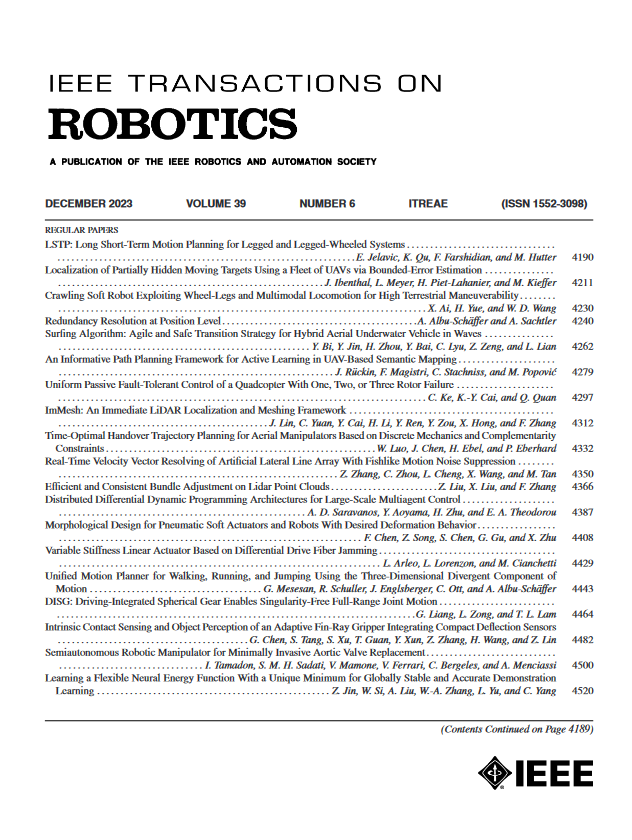A Differential-Mechanism-Based Leg Configuration Balances the Load and Dynamic Contribution for All Actuators of the Quadruped Robot
IF 9.4
1区 计算机科学
Q1 ROBOTICS
引用次数: 0
Abstract
Kinematic performance of a quadruped robot is determined by the mechanical structure. This article presents a novel leg structure for legged robots that integrates a differential mechanism into the conventional design. This approach enables all actuators to be positioned within the robot's torso at fixed locations, significantly reducing the leg's inertia. Furthermore, the new structure introduces a parallel transmission system that balances motion and torque distribution among the joint actuators, effectively reducing torque peaks and enhancing the drive capability during dynamic motions. A family of configurations of differential leg structures is constructed, and their mapping to the classic serial leg structure is dissected in kinematic and mathematic. Simulations of various single-leg models are conducted to validate the performance of the new configuration under typical gait conditions. Subsequently, a leg prototype is designed, manufactured, and tested in experiments involving tasks, such as trajectory tracking, weighted squats, and squat jumps. The development of a prototype quadruped robot featuring this novel leg structure is also presented.基于差动机构的四足机器人腿结构平衡了所有执行机构的负载和动态贡献
四足机器人的运动性能是由其机械结构决定的。本文提出了一种新型的腿式机器人的腿结构,将差动机构集成到传统的设计中。这种方法使所有的执行器都能定位在机器人躯干的固定位置,大大减少了腿部的惯性。此外,新结构引入了并联传动系统,平衡了关节执行器之间的运动和扭矩分配,有效地降低了扭矩峰值,提高了动态运动时的驱动能力。构造了微分腿结构的一组构型,并从运动学和数学上分析了它们与经典串联腿结构的映射关系。通过对各种单腿机器人模型的仿真,验证了新构型在典型步态条件下的性能。随后,设计、制造一个腿部原型,并在实验中进行测试,包括轨迹跟踪、负重深蹲和深蹲跳跃等任务。并介绍了采用这种新型腿结构的四足机器人原型的研制。
本文章由计算机程序翻译,如有差异,请以英文原文为准。
求助全文
约1分钟内获得全文
求助全文
来源期刊

IEEE Transactions on Robotics
工程技术-机器人学
CiteScore
14.90
自引率
5.10%
发文量
259
审稿时长
6.0 months
期刊介绍:
The IEEE Transactions on Robotics (T-RO) is dedicated to publishing fundamental papers covering all facets of robotics, drawing on interdisciplinary approaches from computer science, control systems, electrical engineering, mathematics, mechanical engineering, and beyond. From industrial applications to service and personal assistants, surgical operations to space, underwater, and remote exploration, robots and intelligent machines play pivotal roles across various domains, including entertainment, safety, search and rescue, military applications, agriculture, and intelligent vehicles.
Special emphasis is placed on intelligent machines and systems designed for unstructured environments, where a significant portion of the environment remains unknown and beyond direct sensing or control.
 求助内容:
求助内容: 应助结果提醒方式:
应助结果提醒方式:


